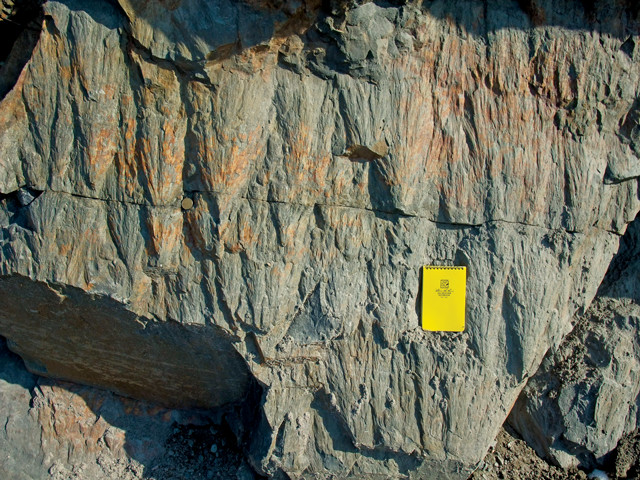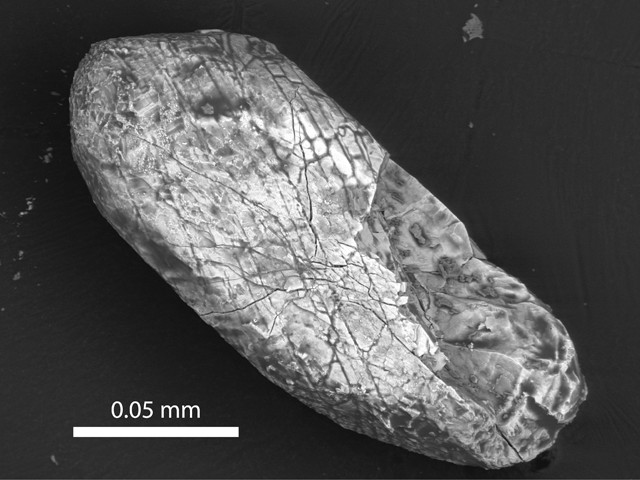
by Kate S. Zalzal Tuesday, August 16, 2016

Shatter cones produced in local rock by the shock wave of the Sudbury impact 1.85 billion years ago. Credit: Gavin Kenny, Trinity College Dublin.
Not much is known about the first 500 million years of Earth’s history, between 4.5 billion and 4 billion years ago. We know the interior of the planet was hotter than it is today, and that Earth’s surface experienced intense meteorite bombardment, which left the surface pocked with magma-filled craters. But with no rock record available from this period — the oldest rocks are 4.04 billion years old — scientists must look to the composition of tiny grains of the mineral zircon to provide clues about Earth during the Hadean Eon. But where did the zircons come from?
The oldest-known zircons in the world, radiometrically dated by uranium decay modeling, formed about 4.4 billion years ago as Hadean magmas cooled. These insoluble, hair-thin crystals later eroded from their parent rocks and were incorporated into new rocks, including Archean-aged metasediments in Western Australia. But in what setting these tiny crystals came to be is unclear. While some scientists suggest the zircons were produced by melts formed at plate boundaries, which hinges on the controversial idea that plate tectonic processes were already underway during the Hadean, there are alternative hypotheses.

A zircon collected from the Sudbury impact crater. Credit: Gavin Kenny, Trinity College Dublin.
In a new study, researchers looking into one possible origin for ancient zircons — that they formed in huge pools of molten rock created by high-energy meteorite impacts — investigated the 1.85-billion-year-old Sudbury impact melt sheet in Ontario, Canada, as an analogue to Hadean craters.
Gavin Kenny, a doctoral student in geology at Trinity College Dublin in Ireland, and colleagues extracted zircon grains from the Sudbury impact melt sheet and measured the crystals’ titanium concentrations, which are indicative of formation temperatures. They then compared Sudbury zircons to Hadean zircons, reporting in Geology that the range of magmatic titanium in the Sudbury zircons is similar to the Hadean-aged population — evidence, the team says, that suggests that Hadean impact melt sheets are a possible source of the most ancient zircons.
Previous work involving impact melt sheets determined that they produce mostly high-titanium zircons, inconsistent with the generally low-titanium values of the Hadean crystals. But, Kenny notes, the molten rock at the Sudbury impact site differentiated as it slowly cooled over roughly 500,000 years, leaving behind layers of compositionally different rocks. Whereas the earlier work looked at zircons from a limited sampling of these layers, “we analyzed zircons from all stratigraphic layers within the melt sheet, and observed a titanium gradient … that includes low-titanium values,” he says. It’s hard to say what happened to the ancient zircons between the time they formed and when they wound up as fragments in the Australian outcrop, but, he says, this study suggests there is no longer any reason to rule out impact melt sheets as a possible source.
The finding is a blow to the Hadean plate tectonics hyphothesis. “Our view of the early Earth is one dominated by impact collisions [with no need to] invoke modern-like plate tectonic interactions,” Kenny says.
But other researchers disagree. Matthew Wielicki, a geochemist at UCLA who was not involved in this study, says impact melt sheets are an unlikely source of Hadean zircons. “It’s great to have a more complete sampling of the [Sudbury] impact melt sheet,” he says, “but when looking at all geochemical aspects of the [ancient] zircons — including oxygen isotopes and inclusions — a more likely analogue is the thermal gradient within [portions of the] hot plate boundary of the modern Himalaya.”
John Valley, a petrologist at the University of Wisconsin-Madison who has been involved in pioneering zircon work but was not involved in this study, points to a middle ground. “It’s hard to rule out impact melting for some zircons,” but, he says, they may also have a more ordinary source. “Many are better explained as coming from a group of granitic rocks called TTGs [tonalite-trondhjemite-granodiorite] that are common in the earliest preserved crusts of the Archean.” Valley says it’s possible that this type of crust existed in the Hadean too, and that it could have undergone a variety of potentially zircon-producing processes, such as plate collisions, meteorite impacts and more.
Kenny, Wielicki and Valley agree that further research should focus on geochemical analysis of inclusions trapped within the zircons, as they may reveal more about the enigmatic genesis of their host crystals.
© 2008-2021. All rights reserved. Any copying, redistribution or retransmission of any of the contents of this service without the expressed written permission of the American Geosciences Institute is expressly prohibited. Click here for all copyright requests.